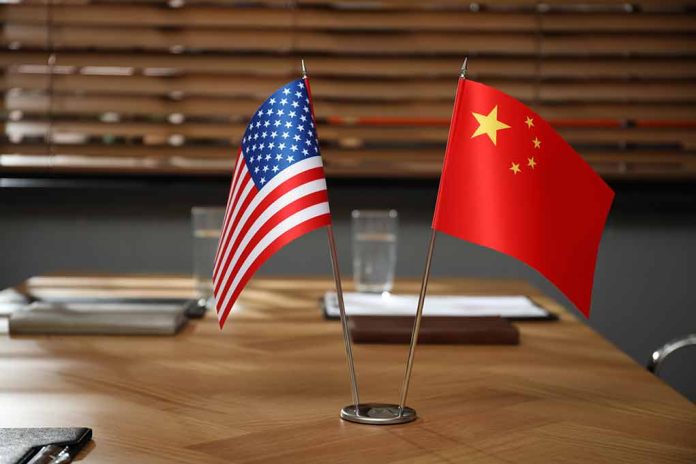
President Trump secures a landmark trade deal with China after just months in office, delivering on his promise to slash America’s staggering $1.2 trillion trade deficit through skilled negotiation rather than submission.
Key Takeaways
- President Trump’s administration has successfully negotiated a new trade agreement with China, addressing the massive $1.2 trillion deficit that has disadvantaged American businesses for decades
- The deal was reached quickly in Switzerland through high-level negotiations, demonstrating Trump’s superior deal-making skills compared to previous administrations
- Trump’s strategic use of tariffs as leverage, despite initial criticism, proved effective in bringing China to the negotiating table
- Treasury Secretary Scott Bessent confirmed substantial progress in the talks, with specific details of the agreement expected to be released soon
- This China trade victory follows a successful UK trade deal, establishing a pattern of diplomatic and economic wins for the Trump administration
Trump’s Trade Strategy Vindicated
President Trump’s administration has announced a groundbreaking trade deal with China, effectively addressing the longstanding $1.2 trillion trade deficit that has plagued American economic interests. The agreement, reached through strategic negotiations in Switzerland, represents a significant victory for Trump’s economic policy and his promise to put America first in international trade relations. Treasury Secretary Scott Bessent reported substantial progress in the talks, with comprehensive details of the arrangement expected to be released to the public imminently. This rapid success stands in stark contrast to previous administrations’ failed attempts to secure favorable terms with China.
U.S. Trade Representative Jamieson Greer emphasized that the quick agreement demonstrates the effectiveness of the administration’s groundwork and negotiation tactics. “This agreement shows what can be accomplished when you have a president who understands business and isn’t afraid to use America’s economic leverage,” Greer stated. The deal’s swift conclusion validates Trump’s controversial but ultimately successful approach of using tariffs as a negotiating tool, despite initial skepticism from economic experts and political opponents who predicted economic downturns and market instability as a result of such measures.
US-China Trade Talks: Seeking Common Ground Amid Tensions
In Geneva, Switzerland, high-level trade discussions between the US and China are underway, marking a potential thaw in the ongoing economic dispute that began under former President Donald Trump. Led by Chinese Vice… pic.twitter.com/ydPc0LO0N9
— Political Maverick (@PoliticalMav) May 10, 2025
National Emergency Approach Yields Results
The Trump administration’s decisive action in declaring a national emergency over the trade deficit created the necessary pressure to bring Chinese officials to the negotiating table with serious intentions. By imposing strategic tariffs, Trump demonstrated that America would no longer accept unfair trade practices that have hollowed out American manufacturing and cost millions of jobs over decades. This approach represented a fundamental shift from previous administrations’ policies, which often prioritized diplomatic niceties over concrete economic results. The success of this strategy has silenced many critics who doubted the effectiveness of tariffs as a negotiation tool.
The negotiations, which took place in Geneva, involved high-ranking officials from both nations working to find mutually beneficial terms. This breakthrough follows closely on the heels of another successful trade agreement with the United Kingdom, establishing a pattern of diplomatic victories for the Trump administration. These consecutive wins demonstrate the president’s commitment to restructuring America’s international trade relationships to favor American workers, businesses, and economic interests. The speed at which these deals are being concluded shows the respect foreign leaders have for Trump’s business acumen and negotiating abilities.
Economic Benefits and Future Prosperity
President Trump has emphasized that this agreement will yield significant economic benefits for American businesses and workers. The deal is expected to create jobs across manufacturing sectors that have been decimated by decades of unfair Chinese trade practices and intellectual property theft. Financial markets have responded positively to the news, with analysts predicting increased stability and growth as trade relations normalize under more equitable terms. This economic boost comes at a crucial time as America continues to strengthen its economic position on the world stage.
The administration’s strategic approach involved careful preparation and skilled negotiation rather than the endless talks and minimal results that characterized previous efforts to address the China trade imbalance. By focusing on concrete outcomes rather than diplomatic photo opportunities, Trump has demonstrated that American economic interests can be protected without sacrificing relationships with major trading partners. As details of the agreement emerge in the coming days, analysts expect to see provisions that protect American intellectual property, reduce non-tariff barriers to American exports, and establish mechanisms to ensure compliance with the terms.













